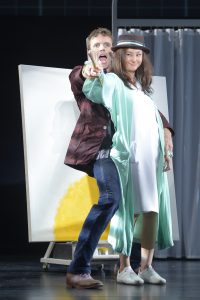Her Life Is The Prize, Those Robots Are Cancer
Yoshimi Battles the Pink Robots is not some zappy Japanese anime game for the cell phone. Instead, it’s a very moving account of a young woman’s battle with cancer. Really. She just happens to be Asian. Named Yoshimi. And “pink robots” is the name her doctor gives to the rogue cells, which are suddenly devastating her body.

Kimiko Glenn and foes in Yoshimi Battles the Pink Robots at La Jolla Playhouse. Kevin Berne Photo
The music and the title come from a 2002 album by the group Flaming Lips, which apparently was vaguely thinking anime. But the stage production now at the La Jolla Playhouse is something else, billed as “music and lyrics by the Flaming Lips” and “story by Wayne Coyne & Des McAnuff.” (Coyne is the driving force of the Lips)
Beyond quibble, this splendid and deeply satisfying show, near perfection in every element, is the creation of McAnuff, whose legendary ability to coordinate musical projects, from Big River through Jersey Boys to last season’s rethinking of Jesus Christ Superstar, has never been more awe-inspiring.
The story here is simple, its shape as streamlined as the rest of the show, crafted to contain securely the emotions being stirred. Yoshimi, having recently broken up with her feckless boyfriend and turned instead to a sleek young businessman, collapses suddenly and is diagnosed with a cancer so terribly advanced that immediate radical therapy is required. Her parents, her doctors and both boyfriends drift in and out of the story as she literally battles the overwhelming menace of the rogue cell robots.
The music, which Coyne has denied was intended as a conceptual whole, works very well as exactly that. The melodies are appealing but not distracting, the lyrics are direct and repeated. This approach bestows upon the songs a sophisticated inevitability that enriches the emotional realities which are the subject of the piece without sacrificing the power of their rock ‘n’ roll origins. “Do You Realize” becomes an anthem. “Mr. Ambulance Driver” is oddly moving. (The titles are confusing, especially to someone unfamiliar with the album. Maybe I should correct that.)
So Ron Melrose’s arrangements for just four musicians are more than just adequate, they’re appropriate. And they merge seamlessly with all the other aspects of McAnuff’s creation to form an organic whole.
Nobody does this merging better than McAnuff and rarely have his results been quite this good.
Each member of the creative team is working at peak efficiency. What’s amazing is that it’s hard to know who’s most responsible for what.
Take these robots. There are 10 of them, plus one big one (about which more shortly) and they are some mixture of Paul Tazewell’s costumes, Michael Walton’s lighting, Bradley Rapier’s choreography and, oh, maybe Steve Canyon Kennedy’s sound design? But they are plenty effective menace and the big guy is unforgettable.
He’s the work of the great puppeteer Basil Twist, who has created a 14-foot high robot that shuffles and stomps and stumbles and eventually steals unwary hearts. But he couldn’t do that without the lighting and Sean Nieuwenhuis’ video and projections and… Well, you get the idea. It just isn’t easy to break this show down for individual kudos.
I will say, however, that’s this is the best set I’ve seen from Robert Brill in awhile, framed in a fluorescent and chrome trapezoid, rigidly uncluttered, hospitable to projections and boasting a ravishing sky drop. Of course all of these are collaborations but that’s what makes this such a ravishing concoction.
And McAnuff is the chef.
He’s the one who chose a lateral, almost 2D look in which diagonals become startling. And he’s the one who envisioned and coordinated the way substantial scenes come and go so swiftly. (The lunchroom! The motorcycle ride! The stock exchange. Well, not so much the supermarket but, hey!)
One of the pleasures of the seasoned theatregoer is watching which way things get done. The iris effect, for example, is done with black flats, two vertical, and one horizontal. But how does one get a free-floating balloon with dangling string to cross with regal aplomb from stage right to stage left? There are many ways, but which did he use here?
And it’s McAnuff who has convinced his large corps of actors (24!) that they can create whole characters with simple looks or gestures: A significant glance between security officers. The way a secretary hops into an office. When and how to pick up a limp girl. Paying the dinner check in a ritzy café with a careless toss of cash.

Paul Nolan and Kimiko Glenn in Yoshimi Battles the Pink Robots at La Jolla Playhouse. Kevin Berne Photo
And, most of all, he has persuaded everybody on view (and probably all those out of sight) that, though they’re all part of this glorious machine, they can be eloquently alive, too. As with Paul Nolan, who makes the slacker boyfriend into everybody’s tower of strength by sheer tenacity, belief and forgiveness. Or Nik Walker, whose eloquent posture projects suave control until it doesn’t. Or, especially, Tom Hewitt as the chief doctor, a complex mixture of arrogance and humbleness, respect and distraction that is instantly recognizable.
This Yoshimi Battles the Pink Robots is something close to a masterpiece, built by a virtuoso storyteller from material powerful but too diffused with cool to deliver this much impact. Until now.
[box] Yoshimi Battles the Pink Robots, by Wayne Coyne, Des McAnuff and the Flaming Lips, continues at the La Jolla Playhouse at 7:30 p.m. Tuesdays and Wednesdays, 8 p.m. Thursdays-Sturdays, 2 p.m. Saturdays and Sundays and 7 p.m. Sundays through Dec. 16. Tickets at (858) 550-1010 or lajollaplayhouse.org.[/box]


